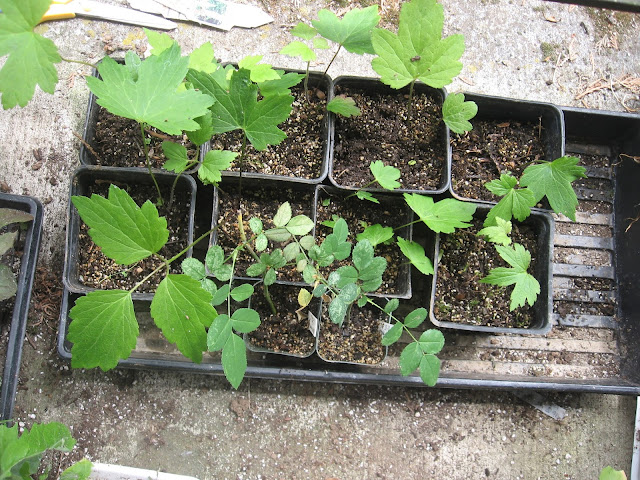I've spread Anemone nemorosa around many beds from just a few of the tubers/rhizomes, and found them very easy to dig and spread in late summer, since they are ephemeral and go dormant below ground when the dry season begins in July, until late winter when they wake up and spread like wildfire. But Anemone japonica/tomentosa require a different technique. I found a good website about taking root cuttings, and dug a few clumps in March, then transplanted the main stems with roots to various places around the garden, and cut 2-3" pieces of root and put them horizontally in the top of some 4" pots in potting soil, peat moss, and perlite, my standard transplanting mix, and covered 1/2" deep, which I then kept on my east-facing concrete porch, which moderates the temperature in winter, acting like a heat sink. For a long time I didn't see any results, but tiny plants began to emerge, and here they are now-
Also in front are a couple of rose cuttings I made last fall that rooted from Madame Plantier, a most exuberant OGR that I obtained from a rooted cutting myself. It was the only one of 6 roses that survived the rooting process, which included using dry powdered rooting hormone and a plastic tent with occasional misting.
But, back to the Anemones, I will try to get them planted out, like most of my other plant starts, in the next couple of weeks before we start getting hotter and drier weather, and hope they will grow.
Here is a list from the above website of other perennials also amenable to root cutting propagation-
"Here's a list of perennials that are suitable for propagation by root cuttings:
Acanthus, Anchusa, Anemone japonica and A. tomentosa, Catananche, Crambe, Eryngium, lardia, some Geraniums, Papaver orientale, Phlox paniculata, Pulmonaria, Pulsatilla, Stokesia, Symphytum, and Verbascum."
Some of these like Symphytum I just divide in spring, Pulmonarias and some hardy Geraniums self-sow well, others I haven't grown or tried out yet.
They do need a moderately cold place to root, like a cold greenhouse, cold frame, or my front porch.
Spring is almost over, so Happy Summer! -Hannah

How exciting to see the success of this technique! Happy Midsummer Hannah!
ReplyDeleteA lot of people have been showing their Acanthus lately, and I am getting enamored of Eryngium, I'm impressed with my 10 year old Phlox paniculata, and I have at least 13 varieties of Pulmonaria, plus lots of self-sown hybrids, so this could be a useful thing to do.
ReplyDeleteI've read several books about Vita Sackville-West and in them it says that she and her friends traded roots. I've often wondered what they did. Great explanation.
ReplyDeleteThanks, I hadn't really considered propagating from root cuttings before, though I know some plants return from small pieces of too left in the ground. It turned out to be pretty easy, I'll see how the little plants do.
ReplyDeleteGreat information. I've done that a few times, too. Sometimes it works, and other times not so much. But nothing ventured, nothing gained, right? Great information, and it's wonderful that you have some new plants from the cuttings!
ReplyDeleteThanks. Now I have even more plants to find homes for before it gets hotter. I'm trying to find places to plant things only to find them full of self-sown geraniums. Maybe too much of a good thing.
DeleteRoot cuttings are an interesting and productive way to propagate. My garden right now is propagating itself through reseeding. In weeding this week, I found several healthy hibiscus and salvia seedlings that I need to pot up. The garden is always full of surprises.
ReplyDeleteHibiscus and Salvia sound like great plants to find growing by themseilves. I have Hibiscus rosa sinensis but have never had them come up from seedlings, though they do root cuttings fairly easily.
DeleteHannah, what an excellent post!
ReplyDeleteThanks, Leigh. I love the Anemone japonicas, it will be great to spread them around. The big ones are already making buds for this year's bloom. They also spread amazingly.
DeleteThanks, Randy. I'm a little nervous about planting the little starts out, since the heat of summer is approaching.
ReplyDeleteVery impressive, and sounds very complicated. I had to giggle when I saw your tagline, since I've spent a lifetime replacing successful plants with weeds - in fact, I'm fairly sure I can kill plastic plants too (today's post is my one exception).
ReplyDeleteGood information on your blog today. My first year gardening here, I started 144 dozen plants. That is true, 144 dozen. The house was full of seedlings. Now I only do a few, like things in the vegetable garden. I am getting lazy, like looking at the lake instead!
ReplyDeleteI am back again, How do I get to follow you on my Blog site? Any help would be appreciated. Jack
ReplyDelete